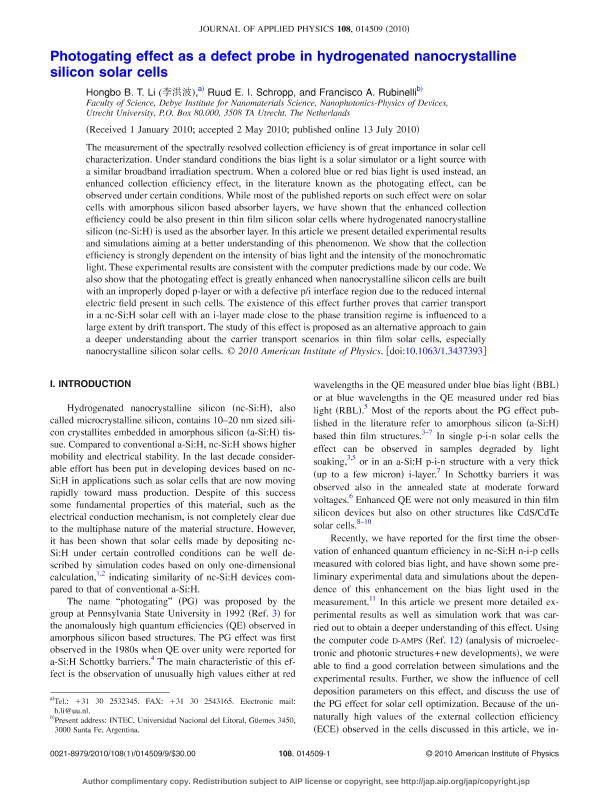Mostrar el registro sencillo del ítem
dc.contributor.author
Li, Hongbo B. T.
dc.contributor.author
Schropp, Ruud E. I.
dc.contributor.author
Rubinelli, Francisco Alberto

dc.date.available
2017-03-09T21:01:46Z
dc.date.issued
2010-07
dc.identifier.citation
Li, Hongbo B. T.; Schropp, Ruud E. I.; Rubinelli, Francisco Alberto; Photogating effect as a defect probe in nanocrystalline silicon cells; American Institute Of Physics; Journal of Applied Physics; 108; 1; 7-2010; 145091-145099
dc.identifier.issn
0021-8979
dc.identifier.uri
http://hdl.handle.net/11336/13706
dc.description.abstract
The measurement of the spectrally resolved collection efficiency is of great importance in solar cell characterization. Under standard conditions the bias light is a solar simulator or a light source with a similar broadband irradiation spectrum. When a colored blue or red bias light is used instead, an enhanced collection efficiency effect, in the literature known as the photogating effect, can be observed under certain conditions. While most of the published reports on such effect were on solar cells with amorphous silicon based absorber layers, we have shown that the enhanced collection efficiency could be also present in thin film silicon solar cells where hydrogenated nanocrystalline silicon (nc-Si:H) is used as the absorber layer. In this article we present detailed experimental results and simulations aiming at a better understanding of this phenomenon. We show that the collection efficiency is strongly dependent on the intensity of bias light and the intensity of the monochromatic light. These experimental results are consistent with the computer predictions made by our code. We also show that the photogating effect is greatly enhanced when nanocrystalline silicon cells are built with an improperly doped p-layer or with a defective p/i interface region due to the reduced internal electric field present in such cells. The existence of this effect further proves that carrier transport in a nc-Si:H solar cell with an i-layer made close to the phase transition regime is influenced to a large extent by drift transport. The study of this effect is proposed as an alternative approach to gain a deeper understanding about the carrier transport scenarios in thin film solar cells, especially nanocrystalline silicon solar cells.
dc.format
application/pdf
dc.language.iso
eng
dc.publisher
American Institute Of Physics

dc.rights
info:eu-repo/semantics/openAccess
dc.rights.uri
https://creativecommons.org/licenses/by-nc-sa/2.5/ar/
dc.subject
Photogating Effect
dc.subject
Microcristalline Silicon
dc.subject
Solar Cells
dc.subject
Internal Gain
dc.subject.classification
Ingeniería Eléctrica y Electrónica

dc.subject.classification
Ingeniería Eléctrica, Ingeniería Electrónica e Ingeniería de la Información

dc.subject.classification
INGENIERÍAS Y TECNOLOGÍAS

dc.title
Photogating effect as a defect probe in nanocrystalline silicon cells
dc.type
info:eu-repo/semantics/article
dc.type
info:ar-repo/semantics/artículo
dc.type
info:eu-repo/semantics/publishedVersion
dc.date.updated
2017-02-24T19:31:02Z
dc.journal.volume
108
dc.journal.number
1
dc.journal.pagination
145091-145099
dc.journal.pais
Estados Unidos

dc.journal.ciudad
Nueva York
dc.description.fil
Fil: Li, Hongbo B. T.. Utrecht Univeristy; Países Bajos
dc.description.fil
Fil: Schropp, Ruud E. I.. Utrecht Univeristy; Países Bajos
dc.description.fil
Fil: Rubinelli, Francisco Alberto. Consejo Nacional de Investigaciones Científicas y Técnicas. Centro Científico Tecnológico Santa Fe. Instituto de Desarrollo Tecnológico Para la Industria Química (i); Argentina. Utrecht Univeristy; Países Bajos
dc.journal.title
Journal of Applied Physics

dc.relation.alternativeid
info:eu-repo/semantics/altIdentifier/doi/http://dx.doi.org/10.1063/1.3437393
dc.relation.alternativeid
info:eu-repo/semantics/altIdentifier/url/http://aip.scitation.org/doi/10.1063/1.3437393
Archivos asociados
